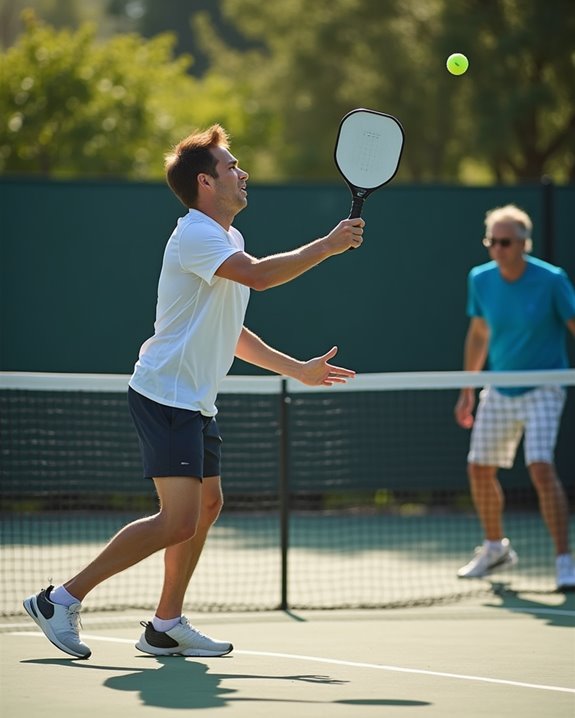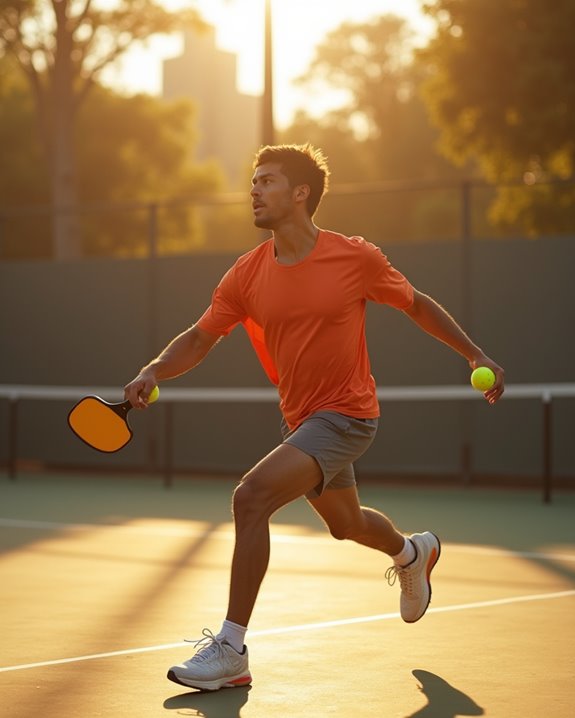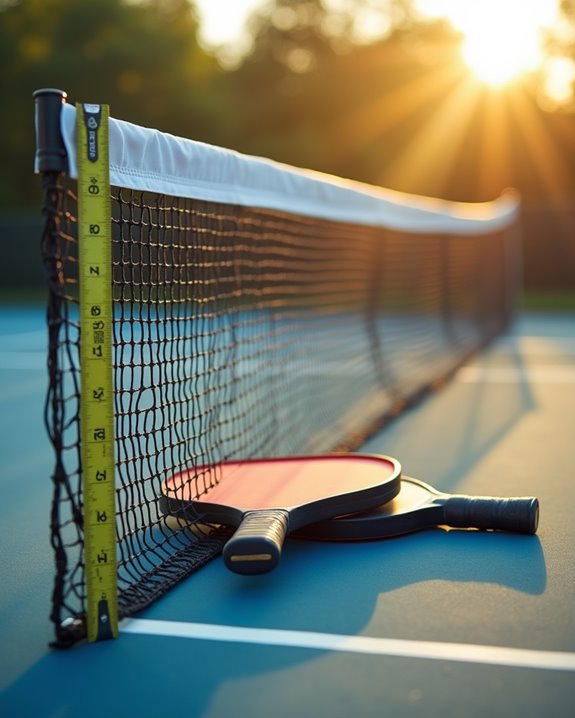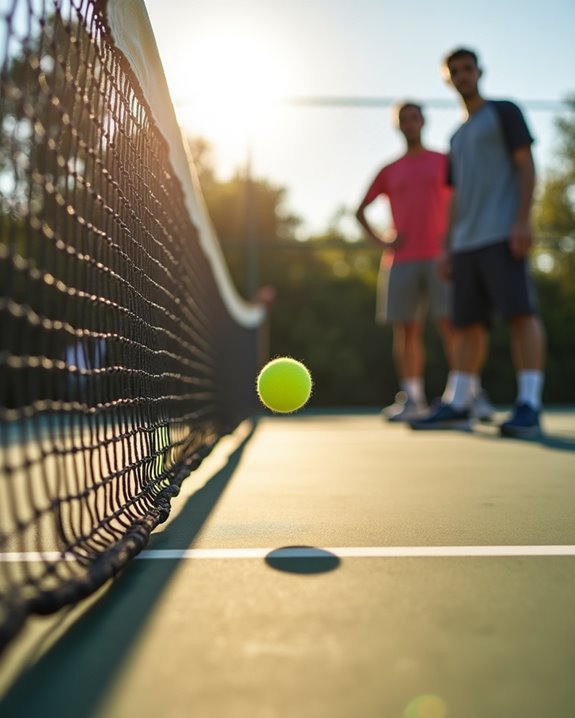While dinking isn’t mandatory when you’re just starting out, it’s like learning to simmer before you sauté. You can initially focus on basic serves, returns, and controlled drives at 75-80% power. Dinking becomes more valuable as you progress beyond novice play, helping you develop “soft hands” and strategic court positioning. Don’t rush to master this delicate kitchen shot immediately—build your foundation first with fundamental skills that will naturally fold into your dinking game later.
Key Takeaways
- Dinking builds foundational control and precision that enhances overall gameplay for beginners.
- Many beginners underestimate dinking, focusing on power shots instead of this essential strategic element.
- Well-executed dinks force opponents into errors and allow beginners to control rally tempo effectively.
- Beginners can develop “soft hands” through dinking practice, improving shot finesse and reducing unforced errors.
- While essential, beginners should balance dinking with other skills like driving, serving, and defensive positioning.
Numeric List of Second-Level Headings
Five essential sections await you in our dinking guide! As you simmer in pickleball knowledge, we’ve prepared a perfect menu of dinking techniques to satisfy your beginner appetite:
- The Perfect Dink Recipe: Master the fundamental ingredients of control and precision
- Kitchen Line Positioning: Learn where to stand for ideal dinking success
- Extending Rallies Through Soft Touch: Reduce unforced errors with gentle placement
- Defensive Dinking Strategy: Turn opponents’ power shots into your advantage
- Progressing Beyond Basic Dinks: Fold advanced techniques into your dinking repertoire
Each section will serve up actionable tips to transform your dinking game from raw to well-done. You’ll learn to patiently mix finesse with strategy, creating a flavorful foundation for your pickleball journey.
What Exactly Is a Dink Shot in Pickleball?
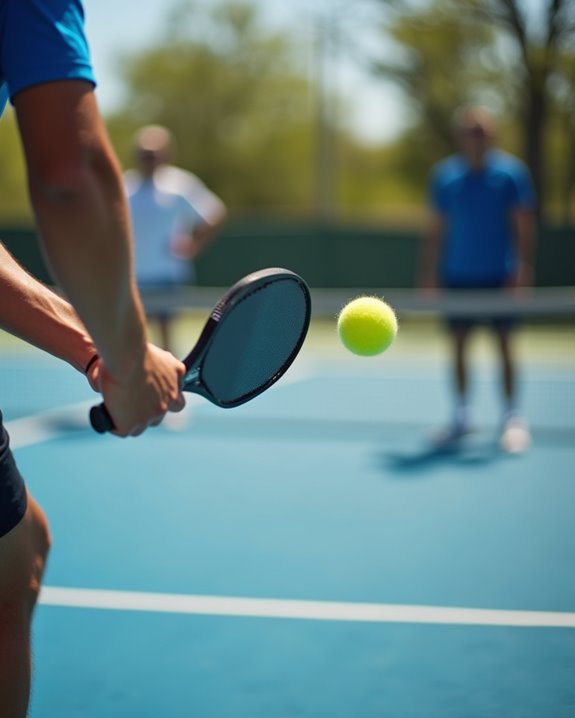
The delicate dink shot serves as the soufflé of pickleball strokes—light, precise, and requiring finesse rather than brute force. When you execute this controlled shot, you’re fundamentally delivering the ball with a gentle touch, angling your paddle face to send it gracefully into your opponent’s non-volley zone.
Mastering the dink is among the most valuable skills in pickleball, much like learning to simmer rather than boil your game strategy. Your dinking techniques will evolve as you practice, transforming raw ability into refined execution. A well-placed dink can force errors from impatient opponents while you improve control of the rally‘s tempo. Think of it as slow-cooking your strategy—patient, deliberate, and ultimately more flavorful than hastily prepared power shots that often result in mistakes.
The Role of Dinking in Developing Player Control
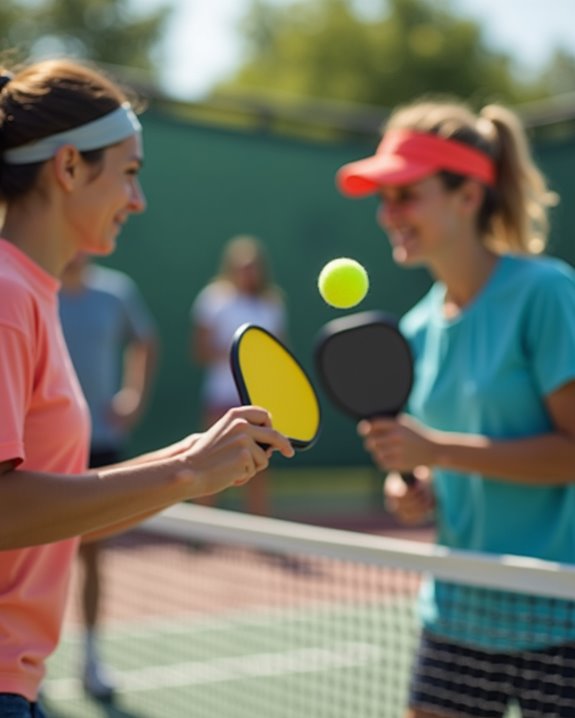
Progressing from understanding what a dink is, let’s now examine how this understated shot functions as the foundation for your overall control development.
When you simmer your dink game at a low heat, you’re actually cultivating precision that will flavor your entire playing style. Your patience at the kitchen line works like a slow reduction sauce—gradually building strategic thinking while eliminating unforced errors from your recipe. The light touch required for effective dinking develops the “soft hands” chefs prize in pastry work.
Proper positioning during dinks guarantees you’re always ready to serve up your next shot. With mastery of this technique, you’ll dictate the pace rather than reacting to it. Like perfecting a signature dish, your player control becomes instinctive through consistent practice.
Common Misconceptions About Dinking for Beginners
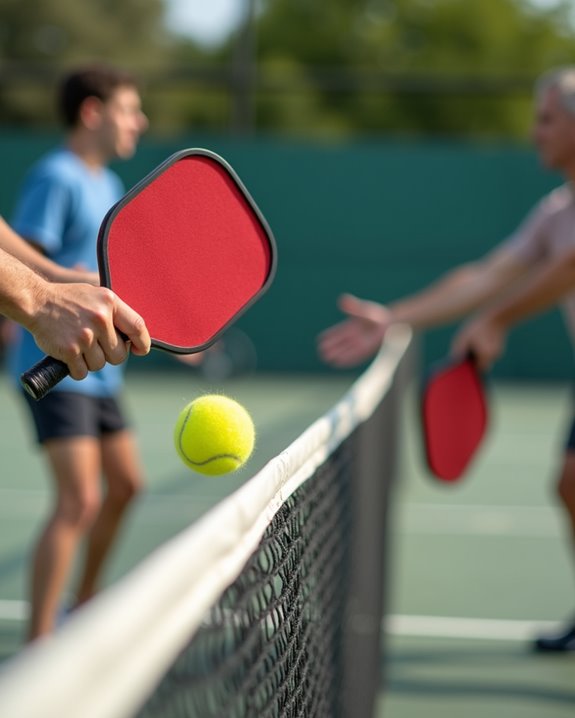
Why do so many new pickleball players underestimate the humble dink? It’s like assuming you don’t need to master simmering before attempting flambé! Beginners often believe power shots are the main course, while dinking is just a side dish. Not true!
You’ll find that dinking isn’t just for advanced players—it’s the foundation that simmers your strategic gameplay to perfection. Many newcomers overlook how soft touches prevent opponents from feasting on high bounces.
Don’t fall for the misconception that dinking is merely hitting softly. It’s actually a defensive tactic that helps you build confidence while you develop control and precision. Think of dinking as marinating your skills—allowing you to prepare before serving up those aggressive shots when the time is perfectly ripe.
Alternative Skills Beginners Should Prioritize
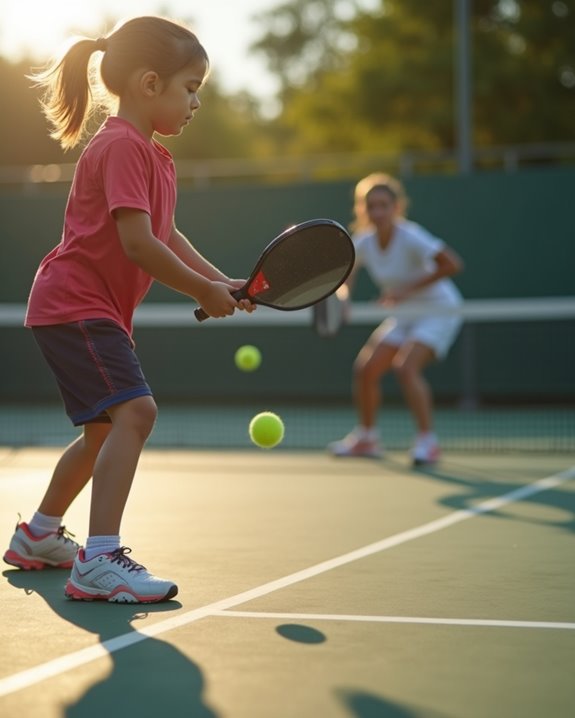
While dinking deserves a place in your pickleball recipe, several other ingredients should be simmering in your skill pan first!
Focus on mastering your driving technique at 75-80% power—this perfect blend of control and placement will serve you better than full-throttle power shots. Your serve and return game needs seasoning too; deep, strategically placed serves create more opportunities than bland, just-in-play attempts.
Fold in defensive skills like recognizing out balls and countering drives to reduce unforced mistakes. These foundational skills are the roux that thickens your game! You’ll maintain control during rallies and develop consistent performance by understanding when a ball is truly attackable. Additionally, consider the importance of grip size and texture as it can significantly impact your control and spin during play.
When Dinking Becomes Valuable in Your Skill Progression
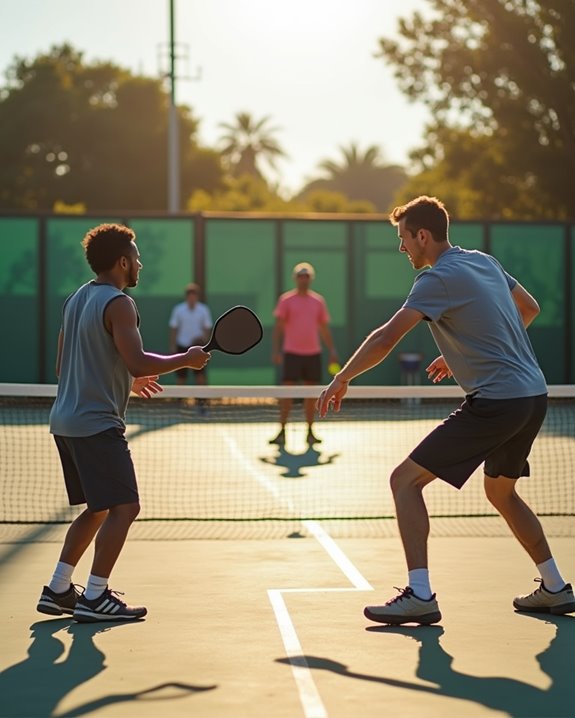
As you develop fundamental control and accuracy, dinking transforms from an occasional garnish to an essential ingredient in your pickleball recipe. This subtle shot begins to shine when you’ve mastered the basics and can place the ball with precision.
Your skill progression naturally leads to longer rallies where dinking becomes a powerful defensive tactic. You’ll notice how a well-placed dink forces opponents into awkward positions—like a chef backing ingredients into a corner. This creates prime opportunities for winning shots.
As beginners evolve, dinking provides the perfect simmer to your game strategy, allowing you to control the pace rather than constantly boiling over with aggressive shots. You’ll develop a balanced approach, knowing exactly when to serve a gentle dink versus when to dish out power.
Practical Drills to Develop Effective Dinking
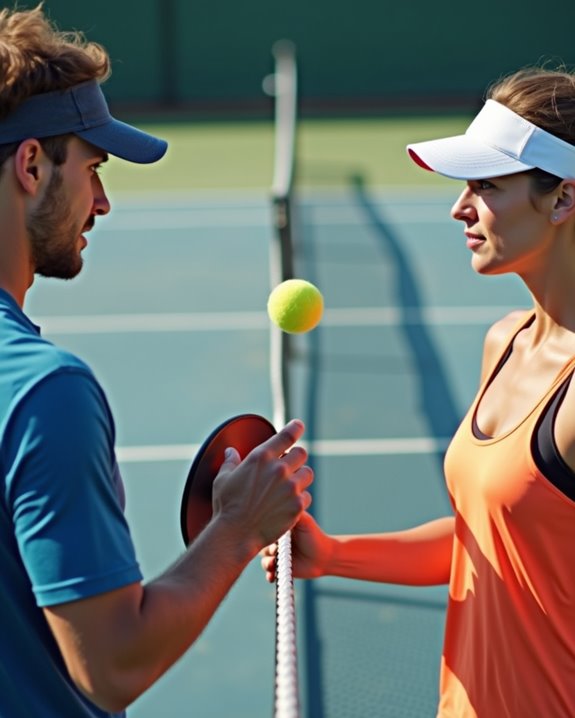
The kitchen becomes your training ground with these essential dinking drills that’ll transform your game. Start by pairing up for dink rallies—aim for 20 consecutive shots to simmer your control to perfection.
The Crosscourt Dink Drill lets you slice shots diagonally, giving you a wider margin for error while you improve dinking precision. Spice things up with the Random Target Drill by placing “ingredients” (cones) in the kitchen and aiming your dinks precisely.
Ready to turn up the heat? The Dink and Attack Drill teaches you to shift from gentle dinking to aggressive shots when opponents serve up a high ball.
Players who hit a great dink aren’t born—they’re made through consistent practice. Schedule these drills regularly, and you’ll soon be serving up dinking mastery!
Frequently Asked Questions
How Important Is Dinking in Pickleball?
Dinking is ABSOLUTELY ESSENTIAL in pickleball! You’ll transform your game by mastering dinking techniques and strategies. Practice dinking drills daily for better control in rallies. It’s far more valuable than smashing, especially for beginners in doubles play.
What Is Considered a Beginner in Pickleball?
You’re considered a pickleball beginner when you’re new to the sport, learning basic rules and court positioning. Typically, you’re still mastering serving techniques and working through common mistakes while developing newbie strategies through practice drills.
What Is the 10 Second Rule in Pickleball?
The 10 second rule requires you to serve within 10 seconds after calling the score. It’s part of serve rules and game etiquette that keeps matches flowing. Violating this timing results in a fault during serve rotation.
What Are 3 Skills Needed to Play Pickleball?
Did you know 53% of pickleball points are won on serves? You’ll need proper racquet grip technique, consistent serve techniques, and strategic court positioning to excel. These fundamental skills create your foundation for success.

